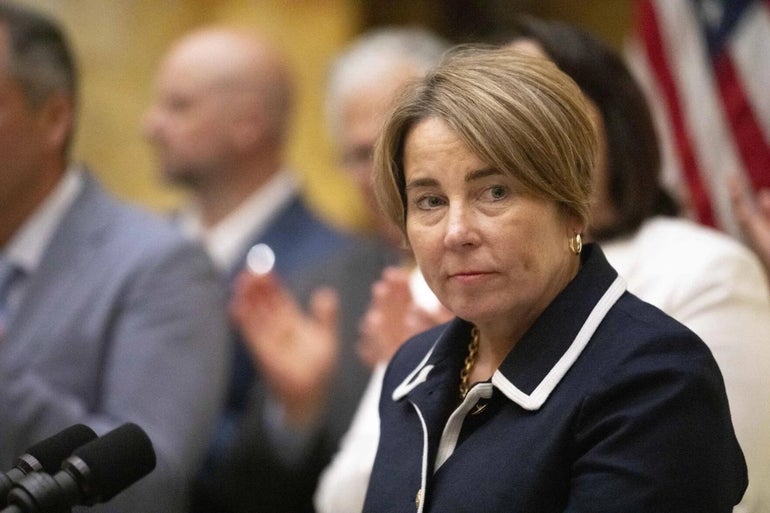Healey announces plan to boost state’s biodiversity, land protections
 Photo I Chris Lisinski/SHNS
Gov. Maura Healey stands at the podium at a June 24 event.
Photo I Chris Lisinski/SHNS
Gov. Maura Healey stands at the podium at a June 24 event.
Gov. Maura Healey announced on Thursday a plan charting a path forward for the state's biodiversity conservation goals and pledging to double the pace of land protection in Massachusetts.
Biological diversity, a term that refers to the variety of all living things and how they interact, is declining at an increasing rate across the globe. "It’s happening everywhere—our oceans, forests and farms, wetlands and beaches, neighborhoods and backyards—but it goes largely unnoticed," the state's plan reads.
The announcement builds off of an executive order Healey signed in September 2023 directing the Department of Fish and Game to conduct a review of biodiversity conservation efforts and recommend goals for the next 25 years. Healey called it "the strongest plan in the country" meant to protect nature.
It's "the first time that any state has made biodiversity targets for 2030, 2040 and 2050, including in our coastal and marine habitats," Healey said at Long Pasture Wildlife Sanctuary in Barnstable.
The state's Clean Energy and Climate Plan targets include protecting 40% of Massachusetts' lands and waters by 2050 and 30% by 2030. By doubling the pace of land protection, the state reports it will be able to achieve those targets. Under the plan, the state would protect an additional 425,000 acres of remaining unprotected key habitats by 2050 "to halt and reverse species loss and build climate resilience."
"It's also a plan to revitalize habitats," Healey said. "When we talk about revitalization, we're talking about removing old dams, fixing culverts, restoring marshes, restoring reefs, supporting our marine economy and our fisheries, protecting businesses and creating good jobs while we do it. And this is a plan to connect more people to nature."
The state plans to use $4 million from its capital plan on initiatives within the plan announced Thursday, Healey said. She added that $370 million proposed in the administration's environmental bond bill, filed in June, is planned for land protection and biodiversity, along with $5 million for marine habitats.
The plan creates a public-private "biodiversity partnership" to help shore up funding. Mass Audubon is the first private partner involved, and has pledged $5 million in funding.
"Massachusetts right now is so well centered in terms of science and technology, and if we can bring funding together through public and private partnerships, this is another way Massachusetts will lead at a time when we're not getting the federal funding for environment and conservation," Fish and Wildlife Commissioner Tom O'Shea said.
The report outlines commitments meant to "connect" communities to biodiversity, including a local grants program, developing a biodiversity-focused curriculum for K-12, after-school and summer programs; and launching a public education campaign related to nature access.
Immediate actions outlined in the plan include leaning on thes environmental bond legislation and creating a dedicated funding source for biodiversity conservation. The plan also suggests the state will increase the Commonwealth Land Conservation Tax Credit and incorporate biodiversity criteria into state grant programs.
The report did not identify a dedicated funding source for conservation. A coalition of advocacy groups called "Nature For Massachusetts" is backing legislation and a potential 2026 ballot question that would funnel a portion of revenue from the state's sporting goods sales tax to create a pool of conservation-specific funding.
The plan also suggests biodiversity credits to enable private companies to finance conservation activities.
"In the UK, they have biodiversity credits. They've explored these market mechanisms to be able to credit biodiversity on land. I think what this is nodding to is the need to figure out what that mechanism would be to help land owners get the true value of their property in terms of ecosystem services," Mass Audubon President David O'Neill said. "Those details still need to be sorted out, but we're very supportive of the concept."
Commitments also include creating safe wildlife crossings, removing obsolete dams and increasing state investments in sewer separation, wastewater treatment and green infrastructure.
"The state has done a fantastic job of identifying and linking the twin crisis of climate change and biodiversity loss. Biodiversity loss does not get talked about as much as the climate problem, and climate change makes biodiversity loss worse," said Noah Matson, chief conservation and climate officer for the Trustees of the Reservation. "Nature protection is part of the climate solution — they're joined at the hip."
The plan also includes expanding the state's Blue Carbon Program and developing a "1% for Massachusetts Biodiversity" initiative, which would encourage companies to meet sustainability and climate goals by donating 1% of annual revenue to fund local biodiversity conservation efforts. It follows a national model called "1% for the Planet."
The plan establishes an inter-agency biodiversity task force and would hire a biodiversity officer to lead a new Fish and Game Office of Biodiversity. It also calls on the state to initiate a public process to explore designating Cashes Ledge, an underwater mountain range in the Gulf of Maine, as a National Marine Sanctuary after it was nominated for consideration in 2024. The designation would make discharges, marine construction or exploitation for oil, gas, or minerals prohibited in the area, according to the report.
"I feel like it's precedent-setting," Matson said of the report. "I think one of the biggest things when you read the report is really framing the importance of nature and nature conservation to our society. It's not just a niche thing or nice to have. It's fundamental to our survival."













0 Comments